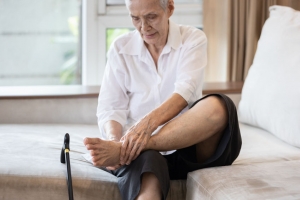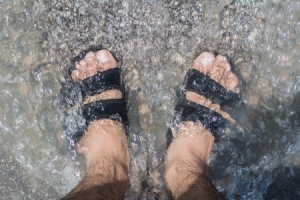Connect With Us
Blog
Displaying items by tag: toenail fungus
5 Foot Care Tips for Seniors
Did you know that the average person walks between 2.5 and 5 miles a day? At Superior Foot & Ankle Care Center we know that means our Los Angeles County senior patients have likely put quite a few miles on their feet. In honor of Older Americans Month 2021, we’d like to offer some tips for protecting podiatric health as you age.
- Listen to your feet. Foot pain, shoes that don’t seem to fit properly anymore, and fatigue in your legs or feet are all ways that your feet communicate that something isn’t right. Don’t put off seeking an evaluation of these symptoms. Contact our Long Beach office at (562) 420-9800 to schedule an appointment with our podiatrists, Victoria M. Foley and Dr. Constance Ornelas.
- Keep feet clean and dry. Wash daily with soap and water and dry thoroughly (paying particular attention to the spaces between your toes). If you tend to sweat excessively, keep an extra pair of socks with you and change when you notice your feet feel damp. This will go a long way in preventing fungal infections like athlete’s foot and toenail fungus.
- Check your feet daily. Look over your entire foot (or ask someone to do it for you) for any unusual changes. Toenail or skin discoloration, bumps, bruises and swelling may all indicate a developing foot or even systemic problem. Diseases such as diabetes, hypertension and arthritis often first manifest in the feet.
- Choose shoes wisely. Your footwear is one of the biggest predictors of podiatric health. Look for styles that have good arch support and heel and insole cushioning. Treads should be non-slip but not have rubber over the toes which can lead to tripping. Ask the podiatrist for recommendations of shoe styles if you have a deformity such as a bunion or hammertoe. Lastly, get your feet professionally measured to ensure a proper fit and always try on both shoes before purchasing.
- Reduce fall risk. Falls are the number one cause of both fatal and non-fatal injuries in seniors. Safeguard your home by installing additional stair rails and lighting. Remove throw rugs, plant stands, electrical cords that are across walking areas, and other clutter to lower your chances of falling.
Your podiatrist is your partner in making sure your feet continue to be healthy and enable you to keep on living the active life you love. If you have any questions or concerns, don’t hesitate to contact us.
7 Ways To Prevent Fungal Foot Infections
A common problem that we at Superior Foot & Ankle Care Center treat in our Los Angeles County patients is fungal infections. Conditions such as athlete’s foot and toenail fungus are very uncomfortable and can easily spread to other parts of the body as well as other people. Most fungal infections are spread by direct contact. That means there are several precautions you can take to greatly reduce your risk. Below are seven tips to help you avoid fungal infections.
- Keep your feet covered in public places. Gyms, community pools, nail salons, and seaside restrooms and changing areas all see a heavy amount of barefoot traffic. Wearing flip flops or shower shoes will prevent your feet from coming in contact with surfaces where the fungi have been deposited.
- Wash your feet daily and dry completely. This simple act will go a long way to keeping fungal and other infections away. Take extra care to dry between your toes as this is where athlete’s foot most often starts.
- Make sure socks stay dry. Fungi love dark, moist places—that’s why the inside of your socks and shoes are the perfect breeding ground. If your feet tend to perspire profusely, keep an extra pair of socks with you and change as soon as you notice your feet feel damp.
- Use foot powder. A dusting of an anti-fungal or talcum powder will aid in keeping feet dry throughout the day.
- Don’t share items that touch another person’s feet. Socks, shoes, nail files, clippers, and even towels can be a vehicle to pass on a fungal infection.
- Choose shoes made of breathable materials. This will allow for air circulation around your feet and reduce the amount of moisture trapped in your shoes.
- Alternate your shoes. It’s helpful to allow shoes to air out for a day or two between wearings.
If you are experiencing red, itchy, flaky skin on your feet or nails that are discolored, thickened, and crumbly it’s important that you schedule an appointment at our Long Beach office at (562) 420-9800. Our podiatrists, Dr. Victoria M. Foley and Dr. Constance Ornelas, will examine your feet and prescribe the correct treatment if you have a fungal infection.
Foot Disorders that Sound Scary (but Aren’t!)
At Superior Foot & Ankle Care Center we thought we’d get into the spirit of Halloween for our Los Angeles County patients by exploring some foot problems that have frightening names. If our podiatrists, Dr. Victoria M. Foley and Dr. Constance Ornelas told you that you had one of the disorders named below, you might panic. But in reality, these are just the medical names for some fairly common and easily treatable conditions. And, our friendly podiatrists would most likely tell you the “user-friendly” name of your foot problem to avoid alarming you!
Tinea Pedis—You’d probably be less scared if you heard “athlete’s foot,” the common name for this itchy skin problem. Often beginning between your toes, the skin will be red, itchy, and flaky. In advanced cases, oozing blisters and cracks in the skin may develop. There are a number of topical treatments that the foot doctor may prescribe to eliminate athlete’s foot. Of course, it’s better to avoid contracting it in the first place. To prevent athlete’s foot, wear shower shoes when walking in public places like community pools and gyms, avoid items that touch another person’s foot, and keep feet dry.
Medial Tibial Stress Syndrome—You may experience this podiatric problem if you’ve recently started a new walking or running program. Its shorter name is “shin splints.” Telltale signs include pain, swelling, and tenderness in the front of the leg on either side of the shin bones. It’s important that you have your legs and feet examined by the foot doctor if you have shin splints because there are a number of different causes of this condition. Left untreated, the pain will get worse and may even lead to a stress fracture.
Onychomycosis—What does it mean when your toenails become discolored and get thick and crumbly? Most likely you’ve contracted toenail fungus—also known as onychomycosis. Fungal toenails are harder to get rid of than other fungal infections. The foot doctor will prescribe the best treatment option for you. We also offer KeryFlex Nail Restoration System to repair nails damaged by fungal infections.
We don’t ever want any of our patients to be fearful about seeing the podiatrist. If you notice anything that looks even a little frightful about your toes, feet or ankles make an appointment at our Long Beach office today by calling: (562) 420-9800.
Archives
Categories
- Featured (163)
- Blog (176)
- Ankle Care (6)
- Ankle Condition (2)
- Ankle Pain (0)
- Appointment Tips (2)
- Arch Pain (1)
- Arthritis (10)
- Athlete's Foot (6)
- Blister (1)
- Bunions (7)
- Calluses (1)
- Child Care (2)
- Circulation (1)
- Common Foot Conditions (4)
- Common Foot Problems (3)
- Corns (0)
- Custom Orthotics (1)
- Diabetes (10)
- Diabetic Foot Care (3)
- Diabetic Footwear (1)
- Edema (1)
- Exercise (4)
- Fall Prevention (1)
- Fitness (1)
- Flat Feet (2)
- Foot Care (19)
- Foot Care Safety Tips (3)
- Foot Care Tips (20)
- Foot Conditions (12)
- Foot Facts (3)
- Foot Health (6)
- Foot Odor (1)
- Foot Pain (5)
- Foot Problems (2)
- Foot Safety (1)
- Foot Surgery Tips (2)
- Foot Warts (2)
- Foot Wear (2)
- Fractures (1)
- Fungal Infection (2)
- General Health (0)
- Gout (5)
- Gout Treatment (0)
- Hammertoe (1)
- Health Tips (46)
- Heart Health (1)
- Heel Pain (0)
- Heel Spurs (0)
- Ingrown Toenails (4)
- Interesting Facts (2)
- Joint Pain (2)
- Leg Conditions (2)
- Leg Condtions (0)
- Men's Foot Health (1)
- Metatarsals (0)
- Nail Fungus (2)
- Neuropathy (1)
- Nutrition (2)
- Obesity (2)
- Osteoporosis (1)
- Pain Relief (5)
- Patient Communications (1)
- Pediatric Foot Conditions (5)
- Pediatric Foot Pain (2)
- Pedicure (1)
- Peripheral Arterial Disease (1)
- Plantar Fasciitis (2)
- Podiatrist Appointment (0)
- Pregnancy Feet (3)
- Proper Shoes (2)
- Senior Foot Care (7)
- Shoe Fit (1)
- Skin Cancer (3)
- Sports Injuries (2)
- Spring Foot Health (1)
- Summer Foot Health (2)
- Toe Pain (4)
- Uncategorized (5)
- Varicose Veins (2)
- Walking (1)
- Women Foot Health (3)
- Youth Sports (2)



